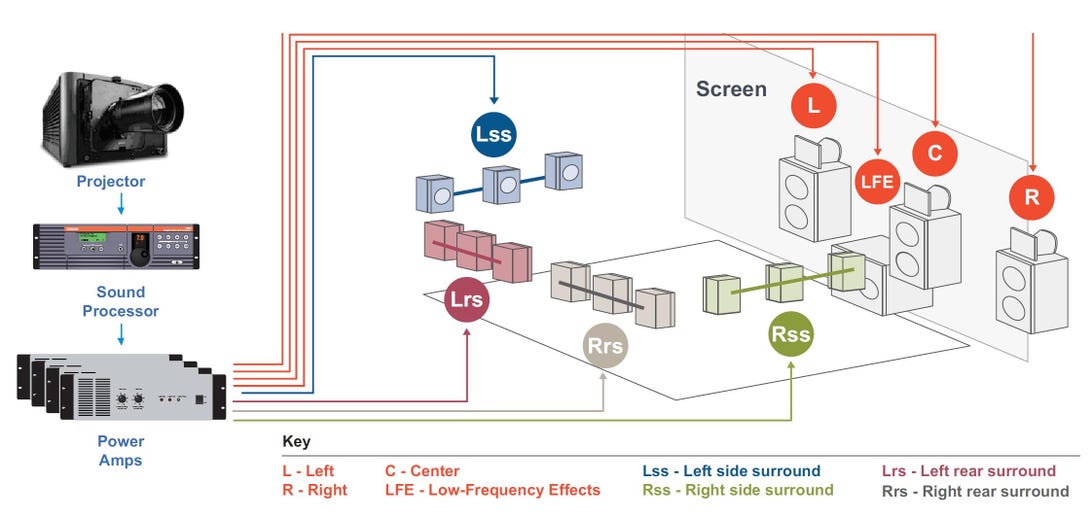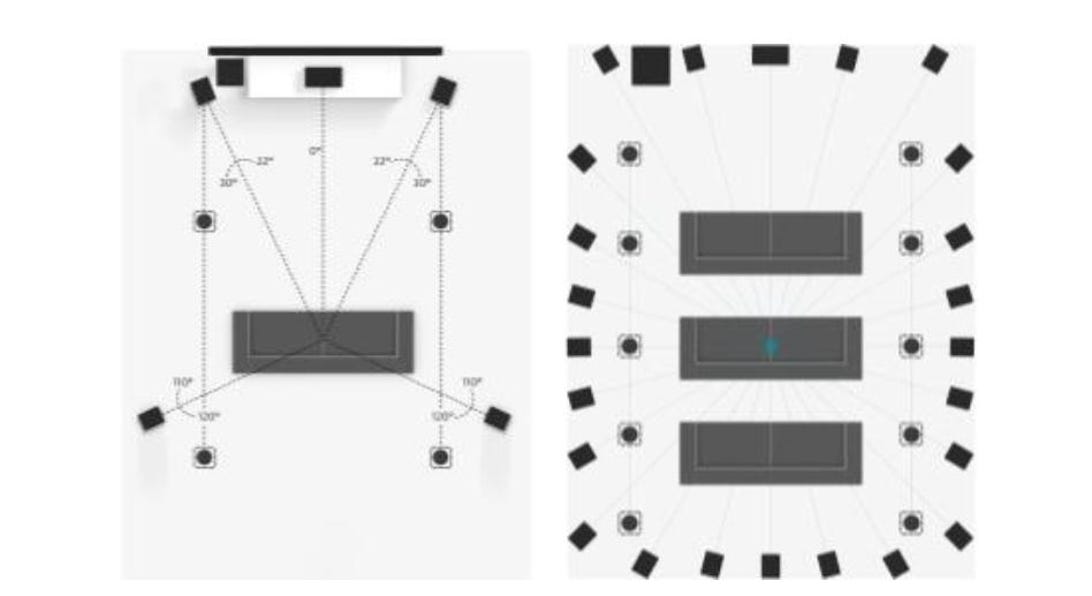Dolby Atmos Makes Me Pay Again After Update

Dolby Atmos can be enjoyed on multiple devices -- including the Apple AirPods 3
David Carnoy/CNETYou may have heard the term"spatial audio" bandied about by Apple tree, especially when talking most its headphones and hardware. It's a standard that tin can convincingly simulate a 3D audio space with a set ofAirPods, but you may non know information technology'due south based on a engineering that's been with united states for many years: Dolby Atmos.
Dolby Atmos is a popular surround-sound format. It's also a competitor to DTS:10, and it'south constitute in everything from the biggest commercial cinemas to domicile theater systems -- and at present it'southward on mobile phones and tablets too. While this format, also known as "immersive," was originally designed for picture theaters, it tin now be used equally a new way to remix and mind to music from the likes of The Beatles andAriana Grande.
While the biggest alter in the movie theatre was the addition of height channels, Atmos soundtracks tin can work with many different systems, no height speakers required. Dolby Atmos tin be replayed on a traditional surround system or even with a pair of headphones thank you to technologies like Dolby Virtual:Ten and Dolby Headphones likewise every bit in conjunction with Apple'due south ain caput-tracking technologies.
In this explainer I'll intermission downwards how Atmos works, why height speakers and upwards-firing soundbars are cool, and everything you've e'er wanted to know almost Dolby Atmos but never bothered to inquire.
A few highlights:
- Meridian channels can create a more immersive audio.
- The best sound will be with a multispeaker setup, just even soundbars with Atmos (similar the Vizio SB36512) offering a much "bigger" and more enveloping soundstage than stereo bars.
- Ceiling speakers are great, but many companies sell upwards-firing speakers that will come up shut in performance without the need for speaker mounting or installation.
Making sound surroundings

The $450 Vizio M512a-H6 is an upcoming Dolby Atmos soundbar.
VizioTo understand what makes Atmos different from, say, its direct predecessor Dolby Digital, let'southward first take a look at how sound is mixed for movies and TV shows.
Everything y'all hear in a movie, from the music to the voices to the sound effects, all gets mixed into specific "channels." For simplicity's sake, nosotros'll say these channels are, as you look at them in a room, left front (L), center (C), correct front end (R), right surround (RS) and left surround (LS). Some more than circuitous systems add "surround back" channels. All the low frequency booms and thumps go to the ".one" subwoofer channel. This diagram should assist:

A traditional 7.1 environs organisation in a theater. Lots of speakers, but only a few "channels" to direct the sound to. And then a sound would come from the left "wall" non a specific speaker on that wall.
DolbyAnd so if 2 actors are speaking onscreen, that gets mixed to the center aqueduct. When the music swells during a dramatic moment, that's ordinarily in the front left and right channels. Zooming and swooping special effects might appear in the environment speakers. To an extent, this same mix of channels likewise translates to the home. Subsequently all, if you lot accept a 5.1 speaker system, you take all those aforementioned speakers.
Except… you don't. Non exactly. Where your speakers are, how powerful they are, and increasingly, how much range each has, varies greatly compared with a decent picture palace.
Atmos, for the most part, doesn't use channels. Instead, well-nigh sounds are treated as "objects." Instead of assigning a sound to a channel (and by extension, a speaker), Atmos lets filmmakers assign a sound to a place. Not "left surround speaker" but "left rear corner." Non "pan from left surround speaker to right sound speaker" simply "pan smoothly across the rear wall." Non but does this give greater flexibility, but it improves the feel in the theater and, potentially, at home.

With Atmos (on the correct), audio designers tin can pinpoint exactly where in whatever Atmos theater they desire a sound to "appear." This could be merely about any place in the room, including overhead.
DolbyAtmos is an end-to-stop modify in theater and home audio. The mixing is different, equally we've discussed, but and so is the decoding. At different theaters the number of speakers tin vary dramatically, but Atmos will scale with them regardless. Most theaters take many speakers along the walls to ensure everyone gets the same-ish experience. With Atmos those speakers can be individually addressable and a sound designer tin pinpoint the verbal location in a theater where they desire to place a sound. A smoother experience for everyone. This is represented in the image above.
This includes the headline Atmos feature: height. With speakers hanging from the ceiling, audio engineers tin can now move sounds seamlessly over your caput and all around. Done right, it'due south non merely more disarming than before, only also less obtrusive. It's more natural, then you're less probable to detect the special effects and more likely to stay captivated in the flick. And that's the point, correct?
So what about the home?

Tidal offers a selection of Dolby Atmos Music titles via its app.
Sarah Tew/CNETTheaters are swell and all, merely most of united states watch more movies at home, fifty-fifty under normal circumstances. Atmos isn't even only near home theater anymore either, as Dolby has been branching the format out into music. Before Apple threw its hat into the band,Tidal and Amazon Music offered a selection of titles that had been remixed in Atmos, and with Sony's competing 360 Reality Audio, the number of beyond-stereo tracks is even so growing.
To let mobile users feel both Atmos music and movies, many newer mobile devices have a version of the engineering called Dolby Atmos for Headphones. Though those are stereo-only, they're designed to simulate Atmos effects with whatsoever headphones. The tech is bachelor for Xbox and PC as well, for $15, via the Dolby Admission app.
If yous're listening at home, though, let's become this out of the manner get-go: Manifestly most people aren't going to install height speakers in their ceiling. That'due south fine because there are a growing number of speakers and soundbars that either feature congenital-in height channels or fit on height of existing models. In the case of a standard tower or bookshelf speaker you tin can fit a speaker model on superlative that has a dissever, upward-firing driver. These speakers bounciness sound off the ceiling to mimic "real" height speakers. I've heard quite a few of these and they work surprisingly well. Not equally well as real height speakers, of form, but information technology works and is a far simpler option if you aren't interested in installing speakers in or well-nigh the ceiling.

The Focal Sib Evo is an Atmos-prepare speaker gear up. Just add a Dolby Atmos receiver.
Sarah Tew/CNETSo, yes, if you lot desire to accept advantage of true Atmos surround you'll need new hardware. Simply Dolby Digital is still the default for everything, so this isn't a required upgrade. If y'all're non interested in Atmos, your gear will still work. Fifty-fifty if y'all go a brand-new 4K streamer to connect to your older receiver, the audio will notwithstanding work if information technology doesn't take Atmos. It volition just play a Dolby Digital or Dolby Digital Plus runway.

2 Atmos domicile setup examples.
DolbyBut if you want height channels, more channels or other benefits of Atmos, then you'll need a receiver or soundbar that tin can decode it and a source that provides it. (Those sources include 4K Blu-ray players, newer media streamers and some game consoles.) And you'll need Atmos content, of course, which we'll discuss in a moment.
To the right, you'll encounter a couple of Atmos dwelling setup examples. At the top, you see a setup with particularly designed upward-firing speakers. Each is a traditional speaker but also has separate drivers that shoot audio to bounce off the ceiling. These are tuned and so the bounced audio sounds correct to your ears. At the bottom, you see a soundbar designed to practise the same.
Atmos as well lets you have a greater number of possible speakers. So how many could you have if you really wanted to go wild? Oh, 24… plus ten superlative speakers. Yep, 34 speakers if y'all want. Yous don't need to practise that, of course. But if you've got a bunch of spare speakers and amps laying around and a room that tin can fit them, become for it.

On the left, a well-installed Atmos home theater system with four in-ceiling height speakers. On the right... good luck with that.
DolbyFor Atmos, Dolby uses a slightly different twist on the nomenclature of abode systems. Traditionally a 5.1 system has three speakers upwards front, 2 on the sides or in back and a single subwoofer. If you then added 2 Atmos height speakers, Dolby would draw this system as a 5.i.2 system. If y'all come across "a 7.two.iv domicile theater" you can deduce that information technology's probably got three speakers up front end, two on the sides, two in back, 2 subwoofers and four height speakers.
All around
In improver to the gear, y'all'll also need Atmos content. That's really pretty easy. If you lot're streaming you lot can find information technology on Amazon Prime Video, Netflix and Vudu. As we noted above, music can be found on Amazon Music Unlimited, Tidal and Apple tree Music. On disc it tin can be found on 4K and regular Blu-ray discs. It's even in a scattering of video games.
Chances are if the picture is 4K, it's also Atmos -- though that doesn't mean it's in Atmos everywhere you can find that movie. It might be available with Atmos on the 4K Blu-ray, just not on Amazon, for example. Merely continue in mind there won't exist compatibility issues. If you buy a motion picture that features Atmos it volition as well accept an audio track your electric current gear tin play, minus the summit channels.
Is it worth upgrading all your gear to take full advantage of Atmos? No. Information technology'due south cool, but if you lot're non a home theater junkie this might be more money than you need to spend if you're not using it. When you're fix to upgrade anyhow, chances are the gear you're considering will have Atmos. For instance,almost of our favorite receivers already work with Atmos, equally do several of our favorite soundbars.
Originally published two years agone. Updated with information about Atmos Music and Apple tree's spatial audio.
Got a question for Geoff? Kickoff, cheque out all the other articles he's written on topics like why you shouldn't buy expensive HDMI cables, TV resolutions explained, how HDR works and more.
Nonetheless have a question? Tweet at him @TechWriterGeoff, and so check out his travel photography on Instagram. He besides thinks you lot should check out his best-selling sci-fi novel and its sequel.
Source: https://www.cnet.com/tech/home-entertainment/dolby-atmos-what-you-need-to-know-about-the-spatial-audio-format/
0 Response to "Dolby Atmos Makes Me Pay Again After Update"
Post a Comment